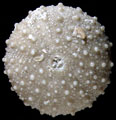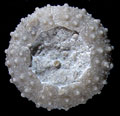The Echinoid Directory
Contributed by Andrew Smith, September 2006
Parorthopsis Smith & Rader, 2009, p. 16
[
]
| Diagnostic Features |
|
|---|---|
| Distribution | Glen Rose Formation, Lower Albian, Lower Cretaceous, Comal County Texas, USA. |
| Type | Orthopsis comalensis Whitney & Kellum, 1966, p. 250 |
| Species Included | May also include Orthopsis repellini (Gras, 1848) |
| Classification and/or Status | Acroechinoidea, Carinacea, Orthopsidae |
| Remarks | Very like O. granularis (Agassiz) and O. miliaris d'Archaic but with aboral tubercles imperforate in both ambulacral and interambulacral zones. Whitney, M. I. & Kellum, L. B. 1966. Echinoids of the Glen Rose Limestone of Texas. Papers of the Michigan Academy of Science, Arts and Letters 51, 241-263, pls 1-2. Smith, A. B. & Rader, W. L. 2009 Echinoid diversity, preservation potential and sequence stratigraphical cycles in the Glen Rose Formation (early Albian, Early Cretaceous), Texas, USA. Palaeobiodiversity and Palaeoenvironments 89, 7-52. |





